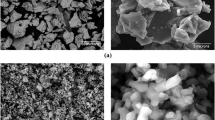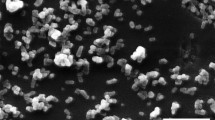Abstract
Titanium rods were processed into implant samples with cavity and groove in which was filled with HAP/β-TCP porous osteoconduction composite materials in order to increase the mechanical stability of the implant in vivo. The phase compositions of the composite was characterized by X-ray diffraction (XRD) and scanning electron microscopy(SEM). Histological evaluation showed that the biogradable composite could enhanced the ability of new bone formation. The composite can conduct new bone tissue growing into the cavities gradually after implanted into animal, and then achieve mechanical fixation. The filling biogradable compound exhibited excellent biocompatibility, which combined with the new bone tissues tightly without inflammation and loosing.
Similar content being viewed by others
References
Dinda G P, Song L, Mazumder J. Fabrication of Ti-6Al-4V Scaffolds by Direct Metal Deposition[J]. Metallurgical and Materials Transactions A-Physical Metallurgy and Materials Science, 2008, 39A(12): 2914–2922
Sandra C P, Cachinho·Rui N. Correia. Titanium Scaffolds for Osteointegration: Mechanical, in Vitro and Corrosion Behaviour[J]. J. Mater. Sci.: Mater. Med., 2008, 19: 451–457
Heinl P, Korner C, Singer R F. Selective Electron Beam Melting of Cellular Titanium: Mechanical Properties[J]. Advanced Engineering Materials, 2008, 10(9): 882–888
Goller G, Oktar F N, Ozyegin L S, et al. Plasma-sprayed Human Bone-derived Hydroxyapatite Coatings: Effective and Reliable[J]. Materials Letters, 2004, 58(21): 2599–2604
Takemoto M, Fujibayashi S, Neo M, et al. Mechanical Properties and Osteoconductivity of Porous Bioactive Titanium[ J]. Biomaterials, 2005, 26: 6014–6023
Fathi M H, Doostmohammadi A. Bioactive Glass Nanopowder and Bioglass Coating for Biocompatibility Improvement of Metallic Implant[J]. Journal of Materials Processing Technology, 2009, 209(3): 1385–1391
Gstottner W K, Baumgartner W D, Hamzavi J, et al. Initial Experiences with the Combi-40 Cochlear Implant[J]. Hno., 1997, 45: 17–21
Liang Hong, Shi Bing, Fairchild Aaron, et al. Applications of Plasma Coatings in Artificial Joints: An Overview[J]. Vacuum, 2004, 73: 317–326
Yankee SJ. Process for Fabricating Hydroxyapatite Coatings for Biomedical Applications[C]. In: Proceeding of the Third National Thermal Spray Conference, 1990: 433–438
Dai Honglian, Cao Xianying, Shao Haichen, et al. Epma Study of the Interface of β-tricalcium Phosphate Ceramics in Vivo[J]. J. Mater. Sci. Technol., 2004, 20(6): 657–661
Xiao X F, Liu R F, Huang Q Y. Preparation and Characterization of Nano-hydroxyapatite/polymer Composite Scaffolds[J]. Journal of Materials Science-Materials in Medicine, 2008, 19(11): 3 429–3 435
Morks M E. Fabrication and Characterization of Plasma-sprayed HA/SiO2 Coatings for Biomedical Application[ J]. Journal of the Mechanical Behavior of Biomedical Materials, 2008, 1(1): 105–111
Ning Chongqin, Zhou Yu. Correlations Between the in Vitro and in Vivo Bioactivity of the Ti/HA Composites Fabricated by a Powder Metallurgy Method[J]. Acta Biomaterialia, 2008, 4: 1944–1952
Wu F, Wei J, Guo H, et al. Self-setting Bioactive Calcium-magnesium Phosphate Cement with high Strength and Degradability for Bone Regeneration[J]. Acta Biomaterialia, 2008, 4(6): 1 873–1 884
Chang YL, Stanford CM, Keller JC. Calcium and Phosphate Supplementation Promotes bone cell Mineralization: Implications for Hydroxyapatite (HA)-enhanced bone Formation[ J]. J. Biomed. Mater. Res., 2000, 52: 270–278
Ciapetti G, Ambrosio L, Savarino L, et al. Osteoblast Growth and Function in Porous poly Epsilon-caprolactone Matrices for Bone Repair: A Preliminary Study[J]. Biomaterials, 2003, 24(21): 3 815–3 824
Author information
Authors and Affiliations
Corresponding author
Additional information
Funded by the National Natural Science Foundation of China (No. 50872099)
Rights and permissions
About this article
Cite this article
Chen, X., Wang, J., Chen, W. et al. Preparation of filling porous osteoconduction materials and its animal experiment study. J. Wuhan Univ. Technol.-Mat. Sci. Edit. 26, 231–234 (2011). https://doi.org/10.1007/s11595-011-0203-7
Received:
Accepted:
Published:
Issue Date:
DOI: https://doi.org/10.1007/s11595-011-0203-7




